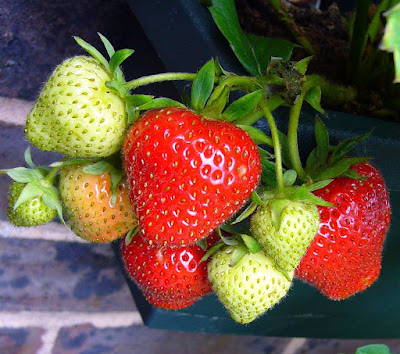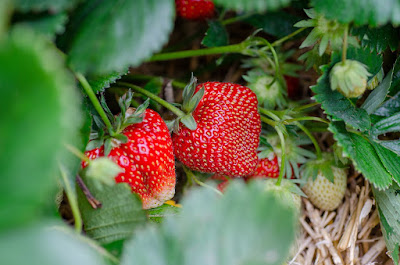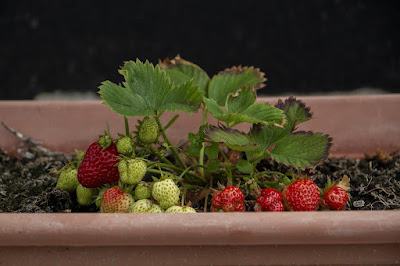How to Grow Delicious Strawberries at Home: From Seed to Sweet
Have you ever considered how enticingly sweet, sugar-rich, and vitamin- and antioxidant-rich strawberries are in addition to being delicious? Think picturing yourself picking a ripe, ruby-red strawberry from your own garden as the sun warms your face and the perfume of the fruit fills the air. You will learn how to raise the juiciest, sweetest strawberries in this course.
Growing healthy strawberry plants isn't just about reaping the tastiest rewards; it's about fostering a connection with nature, reducing your carbon footprint, and savoring the satisfaction of nurturing life from seed to fruit.
Section 1: Choosing the Right Strawberry Variety
It's critical to choose the appropriate strawberry variety for your garden and climate because they come in a variety of flavors, forms, and sizes. In order to guide your decision, let's explore the wide range of strawberries available.
1. Popular Strawberry Varieties for Home Gardens:
a. Strawberries That Bear Fruit in June:
These are the classic favorites, with abundant harvests in late spring and early summer. June-bearers have a concentrated harvest, which makes them ideal for producing jam or enjoying fresh strawberries.
b. Everbearing Strawberries:
These plants, as their name implies, bear berries all during the growing season, with smaller flushes occurring in the spring, summer, and fall. They are appropriate for individuals who desire a consistent supply of strawberries and have a longer picking season.
c. Mountain strawberries:
Alpine strawberries are compact plants that provide tiny, incredibly tasty berries, making them perfect for smaller settings or container gardening. They provide a distinctive gourmet experience and flourish in cooler areas.
2. Characteristics and Suitability for Different Climates:
June-bearers typically excel in temperate regions with distinct seasons, while everbearing strawberries adapt well to a broader range of climates. Alpine strawberries prefer cooler temperatures and are excellent choices for northern areas.
Consider your local climate and the length of your growing season when choosing a variety. If you're unsure, consult with local nurseries or gardening experts for tailored recommendations.
Section 2: Preparing the Garden Bed
The preparation of the garden bed is the cornerstone of a successful strawberry patch. Here, we'll walk you through the necessary actions to guarantee your strawberry plants get off to the greatest start.
1. Ideal Location for a Strawberry Bed:
Select a sunny spot for your strawberry bed, as strawberries thrive in full sun, receiving at least 6-8 hours of direct sunlight daily. This sunlight encourages robust growth, blooming, and fruit production. Ensure the area has good air circulation to prevent moisture-related diseases.
2. Soil Preparation:
a. Testing of the soil:
Do a soil test first to determine the pH and nutrient levels present. pH levels between 5.5 and 6.5 are ideal for strawberries' preferred soil type. The local agricultural extension office or garden centers both offer soil tests.
b. Adding Amendments to the Soil:
Apply soil amendments as necessary based on the findings of the soil test. To improve the structure, drainage, and fertility of the soil, add organic matter, such as compost. This step is crucial for making sure your strawberries have access to the nutrients they require to flourish.
3. Creating Raised Beds or Containers:
Raised beds or containers are good options if you have a small yard or poor drainage. Raised beds make it possible to better manage drainage and reduce compaction of the soil. Container gardening is a great idea for limited spaces or beautiful landscaping, like in strawberry pots or hanging baskets.
When building raised beds, use untreated wood or other suitable materials and fill them with a soil combination that is properly balanced.
You may create the foundation for a fruitful and healthy strawberry garden by picking the ideal location, carefully preparing the soil, and taking into account different growth techniques like raised beds or containers. We'll walk you through planting your strawberry plants successfully in the section after this.
Section 3: Planting Strawberry Plants
Planting strawberries correctly is a crucial step in ensuring a bountiful harvest. In this section, we'll guide you through the timing, spacing, depth, and planting methods for strawberry plants.
1. Timing for Planting Strawberries:
Strawberries can be planted either in the spring or fall, depending on your climate zone. In most regions, spring planting is ideal. Plant as soon as the soil is workable and the threat of frost has passed. Fall planting is suitable for mild climates where winters are not harsh.
2. Step-by-Step Planting Instructions:
a. Site Preparation:
Choose the healthiest, disease-free strawberry plants from a reputable source. Ensure your garden bed or containers are prepared as described in the previous section.
b. Spacing:
For traditional in-ground planting, space strawberry plants 12-18 inches apart in rows with 3-4 feet between rows. This spacing allows for proper airflow and minimizes the risk of disease.
c. Planting Depth:
When planting, ensure that the crown of the strawberry plant (the point where roots meet stems) is level with the soil surface. Planting too deeply can cause rot, while planting too shallow can lead to drying out.
d. Watering:
Water the newly planted strawberries thoroughly to settle the soil and promote root establishment. Maintain consistent moisture throughout the growing season.
3. Planting from Seeds or Bare-Root Plants:
a. Seeds:
If planting from seeds, start them indoors 8-10 weeks before the intended outdoor planting date. Transplant seedlings once they have several true leaves and all risk of frost has passed.
b. Bare-Root Plants:
Bare-root strawberry plants are dormant plants without soil. Soak them in water for a few hours before planting to rehydrate the roots. Follow the same planting depth and spacing guidelines.
Whether you choose to plant from seeds or bare-root plants, following these steps will help ensure your strawberries establish themselves successfully. In the next section, we'll explore the essential care required to maintain healthy strawberry plants and maximize your harvest.
Section 4: Strawberry Plant Care
Caring for your strawberry plants is essential to nurture robust growth and abundant fruit production. Let's explore the key aspects of strawberry plant care.
1. Watering Requirements:
a. Frequency:
Strawberry plants require consistent moisture, especially during dry spells. Water deeply and evenly, aiming for at least 1-2 inches of water per week. Adjust based on weather conditions, avoiding waterlogged soil.
b. Amount:
Water at the base of the plants to keep foliage dry, reducing the risk of fungal diseases. Drip irrigation or soaker hoses work well to deliver water directly to the root zone.
2. Importance of Mulching:
Mulching is important for strawberry growth. It aids in maintaining soil moisture, controls weeds that compete with plants for nutrients, and keeps fruit off the ground, lowering the danger of fruit rot. Apply an organic mulch of 2-4 inches around the plants, leaving space around the crown to prevent rot (straw, wood chips, or shredded leaves are good options).
3. Proper Fertilization:
a. Initial Fertilization:
Apply a balanced, slow-release fertilizer when planting, following package instructions. This provides essential nutrients for initial growth.
b. Ongoing Fertilization:
Fertilize established strawberry plants in the spring when new growth begins. Use a balanced, granular fertilizer or organic options like compost or well-rotted manure. Avoid high-nitrogen fertilizers, which can lead to excessive leaf growth at the expense of fruit production.
4. Dealing with Common Pests and Diseases:
a. Pests:
Keep an eye out for common pests like aphids, slugs, and birds. Use physical barriers such as netting to protect your strawberries. Neem oil or insecticidal soap can help control pests if necessary.
b. Diseases:
To prevent diseases like gray mold (Botrytis) and powdery mildew, maintain good air circulation by thinning plants and removing runners. Apply fungicides if disease symptoms are observed. Rotate your strawberry bed every 2-3 years to reduce disease pressure.
Regularly inspect your strawberry plants for signs of pests or diseases and address any issues promptly. By following these care guidelines, you'll ensure your strawberry plants stay healthy and productive, yielding a bumper crop of delectable berries. In the next section, we'll cover the essential topic of pruning and runner management.
Section 5: Pruning and Runner Management
Pruning and managing runners are essential tasks to maintain the health and productivity of your strawberry plants. Here's why they matter and how to do it effectively.
1. Purpose of Pruning Strawberry Plants:
After the fruiting season, trim away the older stems and leaves to direct the plant's energy toward new growth and fruit production the following year.
Pruning serves several vital purposes in strawberry cultivation:
- Disease prevention:
Older, diseased foliage should be removed to help stop the spread of illnesses like powdery mildew and gray mold.
- Air circulation:
Pruning improves air circulation around the plants, which lowers the risk of fungus and encourages stronger growth.
2. Guidelines for Removing Runners:
Runners are long stems that extend from strawberry plants, eventually forming new plants if left unchecked. While they can be useful for expanding your strawberry patch, managing them is crucial:
- Pinching Runners:
Pinch or snip runners regularly to prevent them from drawing energy away from fruit production. Use clean scissors or pruning shears to make clean cuts.
- Selectively Propagate:
If you wish to expand your strawberry patch, allow a few runners to develop and root in a separate area. This controlled propagation method ensures healthier new plants.
- Maintaining Spacing:
Ensure proper spacing between strawberry plants to avoid overcrowding, which can lead to disease and reduced fruit size.
By pruning and managing runners, you'll maintain vigorous, disease-free strawberry plants that continue to produce high-quality fruit. In the following section, we'll guide you through the exciting process of harvesting your homegrown strawberries.
Section 6: Harvesting Strawberries
The tastiest and juiciest fruit is obtained when you pick your homegrown strawberries when they are at their prime freshness. This is how to do it correctly:
1. When and How to Harvest Ripe Strawberries:
- Timing:
Strawberries are ready for harvest when they are fully red, plump, and have a glossy appearance. For June-bearing varieties, the main harvest typically occurs in late spring or early summer, while everbearing types yield fruit throughout the growing season.
- Technique:
Gently grasp the stem just above the berry and twist it with a slight tug. Ripe strawberries should easily detach from the stem, leaving the cap intact. Avoid picking unripe green or white strawberries, as they won't ripen after harvesting.
2. Proper Handling to Avoid Fruit Damage:
- Handle with Care:
Strawberries are delicate, so handle them gently to prevent bruising or damage. Use clean, dry hands to pick and handle the fruit.
- Avoid Stacking:
Don't stack or pile strawberries on top of each other, as the weight can crush the lower berries.
3. Storage Options and Shelf Life:
- Immediate Use:
Strawberry flavor and texture are best when enjoyed shortly after being freshly plucked. Please use immediately.
- Short-Term Storage:
If strawberries won't be consumed right away, they should be stored in a single layer in a refrigerator-safe container with adequate airflow. Wait until shortly before eating to wash them to avoid moisture-related degradation. For two to three days in the fridge, strawberries keep well.
- Long-Term Storage:
For long-term storage, wash, shell, and pat dry strawberries before freezing. Spread them out on a baking sheet and then transfer them to a freezer-safe bag or container so they can freeze separately. Frozen strawberries can be stored for a number of months and are suitable for smoothies, jams, and baked goods.
Strawberry harvesting is a satisfying activity. You can get the most out of the sweet flavor of your homegrown strawberries by following these instructions. We'll discuss several scrumptious ways to enjoy the benefits of your labor in the last part.
Section 7: Enjoying the Fruits of Your Labor
It's time to enjoy the tasty rewards and get inventive in the kitchen now that you've produced and harvested your own sweet strawberries successfully.
1. Strawberry Recipes to Savor:
a Strawberry Shortcake:
Make a traditional strawberry shortcake by sandwiching flaky biscuits or sponge cake with cut strawberries and sweetened whipped cream. It's the ideal treat for the summer.
b. Strawberry Jam Made at Home:
Make homemade strawberry jam to preserve the goodness of your bounty. It tastes great on toast, yogurt, or desserts.
c: Strawberry smoothies, :
An energizing and nutritious strawberry smoothie can be made by blending fresh strawberries with yogurt, honey, and a banana. Ice can be added for a cool treat.
2. Preserving Excess Strawberries:
If you find yourself with an abundance of strawberries, consider these preservation methods:
a. Freezing:
Hull, slice, and freeze strawberries for use in future recipes, like pies, muffins, or smoothies.
b. Drying:
Dehydrate strawberries for a crunchy snack or to use in granola, trail mix, or as a topping for oatmeal.
c. Canning:
If you have a large harvest, consider canning strawberries to enjoy their flavor year-round.
In Conclusion:
Here are the main points to remember from our advice on how to produce strawberry plants:
- Select the best strawberry variety for your needs and climate.
- Add the appropriate amount of soil amendment to a sunny, well-drained garden bed.
- Plant your strawberries in the spring or fall, keeping in mind the recommended depth and spacing.
- Offer regular maintenance, such as watering, mulching, fertilizing, and insect control.
- For plants that are healthier, prune and control runners.
- Strawberries that are ripe should be picked carefully and stored properly.
- Using different recipes and methods of preservation, take pleasure in the rewards of your labor.
Home strawberry cultivation offers a variety of advantages, including fresh, tasty fruit, a closer relationship with nature, and a smaller carbon imprint. Please share your ideas, inquiries, and triumphs in the comments section below.
Thank you for joining us on our strawberry-growing expedition! Remember to follow our blog so you can stay up to date on the latest gardening tips and ideas. With wise knowledge, we'll keep feeding your green thumb.
To get daily inspiration, follow us on social media, where we constantly post beautiful pictures and gardening-related stories.








Join the conversation